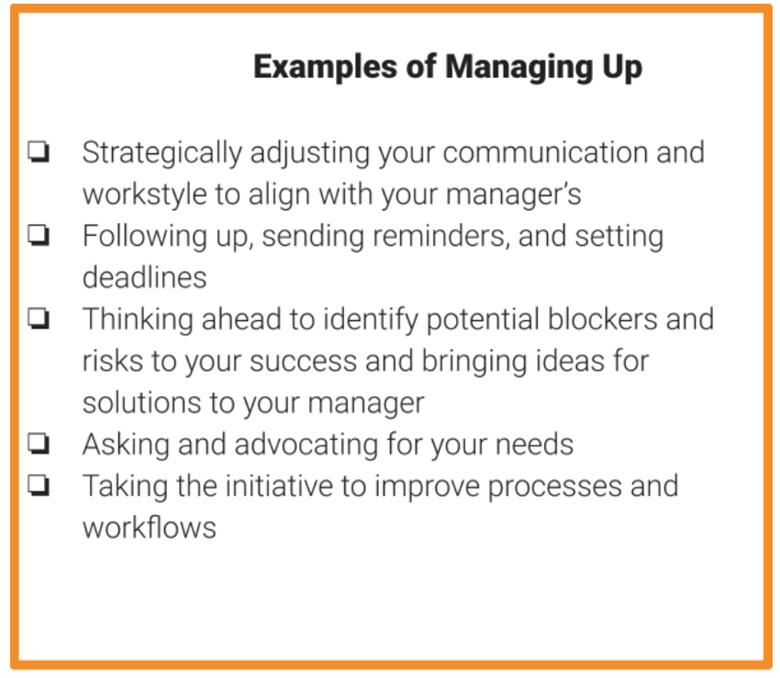
Managing Up: Meaning, Benefits, Examples
When most people picture “managing others,” the image that likely comes to mind is that of top-down management. Bosses instruct and coach their direct reports, who then go on to manage the people underneath them. But in most organizations, “managing” should be happening from the bottom-up, too.
Relationships—including those of employees and their managers—are a two-way street. And, at the end of the day, managers are human. It’s unrealistic to expect your manager not to “drop the ball” every now and then. A busy manager might forget to review a document or miss an important email thread. Or maybe you’ve found your manager has more significant weaknesses—like difficulty communicating their expectations, or failing to provide useful feedback. But despite their shortcomings, managers have a lot of influence over their employees’ career progression. So what do you do when you find your manager standing in the way of your own success?
What is managing up in the workplace?
Managing up is essentially managing your manager—doing what you can to get what you need from your manager to do the job to the best of your ability. Managing up requires proactive problem-solving, and a well-rounded understanding of who your boss is as a professional—including their strengths, weaknesses, and work preferences—is key to mitigating risks to your success before they arise.
Your job isn’t necessarily to make your boss’s job easier, but making your boss’s job easier will make your job easier as a result. Practically speaking, managing up could look like:
 For example, maybe you learn that your boss only checks her email twice a day—first thing in the morning and right before she signs off at night. Armed with this knowledge, you can adapt how you communicate time-sensitive matters that require her immediate response and only use email for non-urgent requests. Say you’re in the midst of preparing an important document for a client, and your boss typically takes a day or two to review documents you’ve drawn up. But this time, you need to send the document within hours. In this instance, managing up could involve sending the document in Slack instead of email, or attaching the document to an email but immediately following it up with a text explaining why you need a shorter turnaround for review.
For example, maybe you learn that your boss only checks her email twice a day—first thing in the morning and right before she signs off at night. Armed with this knowledge, you can adapt how you communicate time-sensitive matters that require her immediate response and only use email for non-urgent requests. Say you’re in the midst of preparing an important document for a client, and your boss typically takes a day or two to review documents you’ve drawn up. But this time, you need to send the document within hours. In this instance, managing up could involve sending the document in Slack instead of email, or attaching the document to an email but immediately following it up with a text explaining why you need a shorter turnaround for review.
Misconceptions About Managing Up
The most common misconception about managing up is that the only people who need to learn how to manage up are those with bad bosses. While managing up may be more of a necessity for those who find themselves under the purview of a particularly difficult manager, managing up is a skill that every employee should cultivate. For people with great bosses, learning how to manage up will only improve productivity—and the relationship. Proactively identifying areas of inefficiency and seeking to improve workflows will show your manager that you’re a team player and are invested in your role.
Another common misconception is that managing up is insubordination. To be clear, managing up does not involve inappropriately going over your manager’s head or balking at an assignment. Your boss is still your boss, and this requires a certain level of respect. But you can ask for what you need and manage the timeline while being kind and staying “in line.” In fact, seeing as though your manager is responsible for both her career and yours, she will likely be pleased to see you taking the initiative to get what you need from her.
Finally, a lot of employees worry that managing up will damage the relationship with their manager. While this outcome is possible if you’re rude, overly demanding, or unkind, it’s unlikely that the self-advocacy managing up requires will cause harm. In fact, not speaking up for yourself may do more damage to the relationship in the long run. As one manager once wrote on the topic, “I always want to know if there’s something that would make my people more effective, even if it requires some of my time or company resources.”
Benefits of Managing Up
It’s hard to overstate the benefits of managing up, because effectively managing up will result in work successes that reflect positively on both you and your manager. Some of these benefits include:
- Increased trust and an improved relationship between you and your boss
- Improved communication skills
- Goal achievement
- More opportunities for career progression and professional development
- Development of essential leadership skills
- Increased accountability
- Improved productivity and performance
Key Skills for Managing Up
Many of the leadership skills needed to effectively “manage up” are the same as those needed to “manage down.” These include:
- Communicating clearly and concisely
- Asking good questions
- Self-awareness
- Giving feedback
- Active listening
- Problem-solving and critical thinking
- Conflict resolution
How to Manage Up Effectively
Managing up isn’t difficult with the right tools, but it does take time and intentionality. Here are five steps to put managing up into practice.
- Get to know your manager’s strengths, weaknesses, preferences, and workstyle. To manage up effectively, you need to know what makes your boss “tick.” Learning how your manager prefers to work and then adjusting your workstyle to complement theirs is foundational to managing up successfully. If you haven’t already had a conversation to discuss workstyle and communication preferences, this will be the very first step you’ll need to take to start managing up. Assessments, like DISC and CliftonStrengths, are excellent tools you can use to create shared definitions around workstyle and communication preferences—as well as blind spots you may need to work around in the future. Getting to know your boss in this way will make it easier for you to put yourself in their shoes and see things from their perspective. A little empathy can go a long way—especially when managing up.
- Steer clear of making assumptions. We all know what they say about assumptions, and there’s a reason why an incorrect assumption can lead to you making an “ass” of yourself. Many a relationship—at work and otherwise—has seen damage because one person thinks they know the unknowable: the other’s reasons or motivations for doing or not doing or forgetting to do something. When we make assumptions, we create fictional stories about the other person—and often those stories reflect poorly on them. After all, we humans are hard-wired for negativity. For example, let’s say your boss leaves a text message containing an important question you sent on “read” and doesn’t respond for several hours. You could build a story in your head about how she doesn’t care about you or doesn’t like you, or how she’s lazy and forgetful. You may even begin to wonder why she hired you in the first place if she places such little value on giving you what you need for a project. Suddenly, you’re calling your entire relationship with your boss into question. When she finally does respond, she is apologetic and explains how she was called into a meeting and accidentally left her phone in the car. It can be hard not to assume the worst, but you’ll be better able to manage up if you reserve judgment and keep an open mind about your manager’s motivations.
- Get clear on goals and priorities. At the end of the day, both you and your manager likely want the same thing: for you and your team to be successful. With this knowledge as the foundation, it’s important to periodically have conversations that provide clarity and alignment around goals and priorities. Getting on the same page is a key factor in managing up. Meeting weekly with direct reports one-on-one is a widely-accepted management best practice, so if you don’t already have this time with your manager set up each week, take the initiative to schedule it. This weekly one-on-one is critical to managing up, as it will also provide a forum for asking questions, making requests, and getting clarity on expectations.
- Be patient. Building your managing up muscle will take time and practice, so be patient with yourself—and your manager. There will probably be mistakes and missteps along the way, but instead of seeing these as failures, view them as opportunities for improvement. The best way to learn is by doing, so every mistake offers a chance to learn. What’s more, you’ll need to be patient with your manager, too. Adapting to a new way of working together will take time on her end as well, especially if her plate is already full. The shift will likely benefit everyone in the end, but keep in mind that there will be a “getting used to something new” period for both of you.
Managing Up to Prime Your Boss, Team, and Department For Success
At the end of the day, the benefits of managing up extend beyond just you. In proactively setting yourself up for success, you’ll also be priming your boss, team, and department for success as well.






